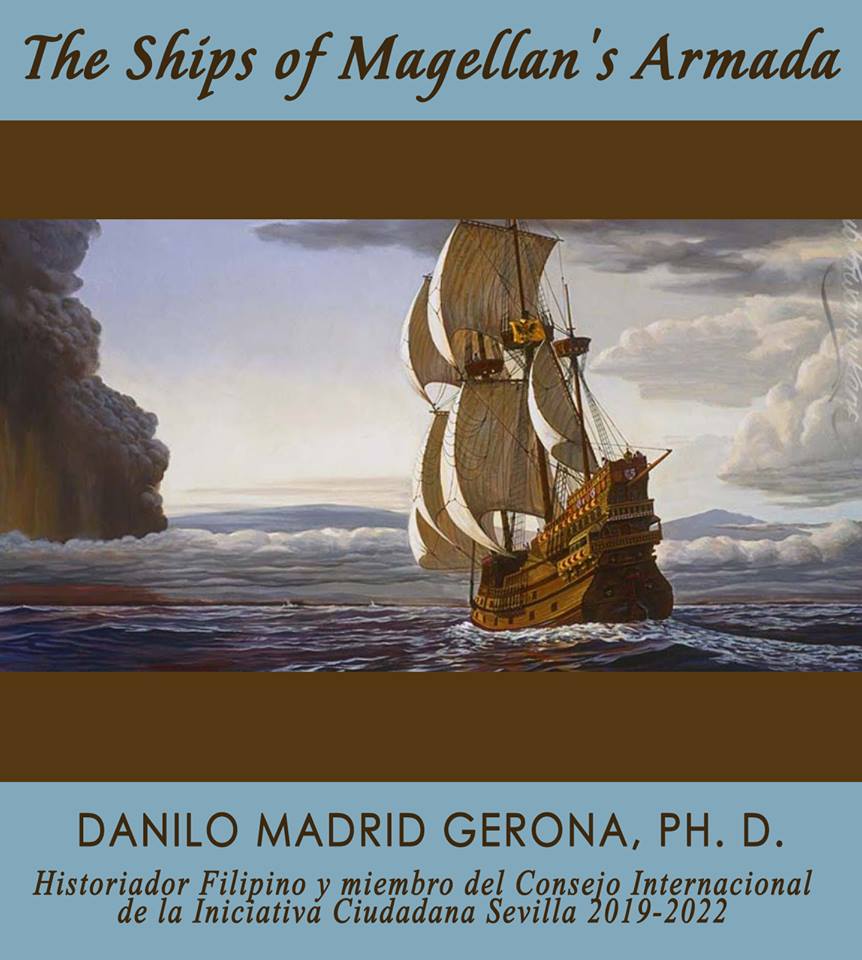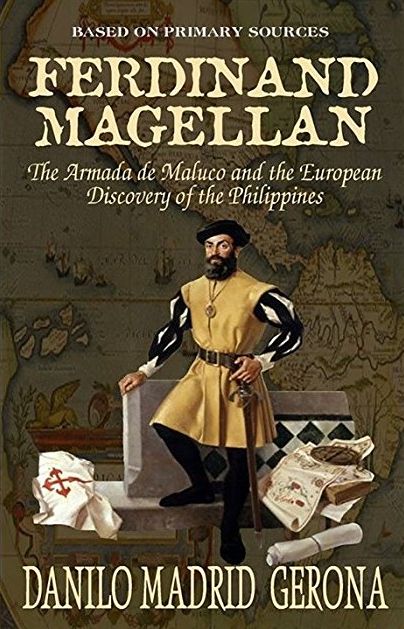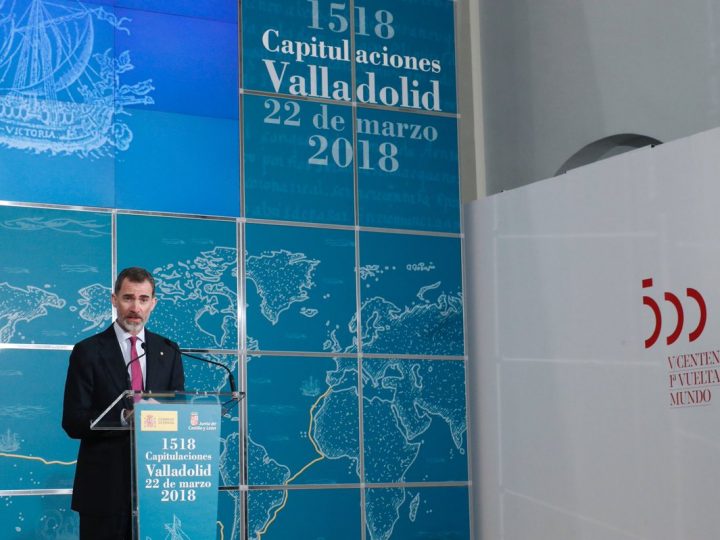
On 22 March 1518, the date of the signing of the Capitulacion, a frenzied preparation for the journey began with the negotiations for the purchase of the fleet.
Charles’ royal decree on that same date announced, “we have ordered the refitting of 5 ships with men and provisions and other things needed for the voyage.” It was not clear why the King had only allocated five ships for this expedition but it appears that much of the planning and arrangement were made by a host of advisers from the Casa de Contratacion. Included among these persons trusted by the King was Juan de Aranda, who in his decree on July 20, 1518, was assigned the task of facilitating the preparation for the expedition. Aranda searched for these ships in the harbor of Cadiz, a seaside city enjoying a flourishing maritime commerce and abounding with vessels plying the Atlantic line to the New World. From 1504 until 1518, when the Crown began the preparation for the expedition, an average of twenty to thirty vessels sailed each year from these shores. The increase in the quantity of these vessels was attributed to the creation of a branch of the Casa de Contratacion in the city by a royal cedula issued by Queen Juana on 15 May 1509. It was from these array of decommissioned ships lying idly for sometime on the shores of Cadiz, with palpable signs of neglect and disrepair, that Aranda made his purchase.
Based on the Armada’s official report on the expenses, the entire fleet consisting of five ships amounted to 1,316,250 maravedis. The most expensive was the San Antonio, bought at 330,000 maravedis. For unknown reasons, the second smallest vessel, the Victoria, ranked next to the most expensive at 300,000 maravedis. The second largest and the expedition’s flagship, the Trinidad, was only worth 270,000 maravedis. The Concepcion was priced at 228,750 maravedis while the Santiago, the smallest from the five vessels, was bought in the amount of 187,500 maravedis.
A smaller vessel known as esquife, bought in the amount of 37,437 maravedis accompanied the flagship Trinidad. A number of these esquipes hang on the side of the ships to transport passengers or crew from one ship to another in the open sea and also to ferry them to the shore. The account of expenses listed under the categories of naos y aparejos, included an entry amounting to 49,584 maravedis spent for the construction of a bergantin, a small two-masted vessel widely used in the sixteenth century with riggings made up of square sails.
Magellan had the hand in the naming of the ships. The Trinidad was named after the Holy Trinity, the Santiago was adopted from the name of the Patron Saint of Spain and of the military order where Magellan belonged. The Concepcion was adopted from one of the most popular objects of Marian devotion of the Sevillanos, the Immaculate Conception, long before she was officially declared in 1854 as part of the dogma of the Church. The San Antonio was named after the thirteenth century Portuguese saint, Anthony of Lisbon but popular as Anthony of Padua. Magellan’s choice for a Portuguese saint to name this ship was probably made in consideration of his need for a compatriot to be his celestial ally and protector.
The Victoria, considered by historians as the most important among these ships, immortalized the name of the chapel in Triana, the Santa Maria de la Victoria, where Magellan regularly complied with his religious obligations while in Seville. A newly discovered document by a Basque researcher, Fernando Agirre Aramaio, (a copy of which was sent to me by my Spanish friend, Julian Diaz of Ondarroa in Bizkaia) dated September 23, 1518, revealed startling information unheard of for the last five hundred years.
The document showed that the ship Victoria was originally named Santa Maria, owned by Domingo de Apallua, a ship pilot and his son, Pedro de Arismendi, both residents of Ondarroa in the province of Bizkaia in the Basque region. According to this notarial document, the ship had been used earlier for maritime commerce between London and Castile. Acquired by royal representatives at 800 ducats in gold, an amount the owners grudgingly accepted, even “against their (the owners) will,” as they deemed the price inadequate being lower than the actual cost of the ship. The purchase price had an equivalent value of 300,000 maravedis, the standard and basic unit of currency at that time, an amount consistent with the declared value of the ship as recorded by the accountant of the Armada. Although Basque historians were unanimous in their claim that it was built in their region, they, however, disagreed on the exact location. One claimed it was built in a village called Zarautz in Guipuzcoa under the direction of Juan Sebastian del Cano while another held on to the town of Ondarroa in Bizkaia.
Of imposing sizes, these vessels dwarfed Columbus’ three smaller ships which earlier sailed from Palos near Cadiz on 3 August 1492. The two largest vessels were slightly bigger than Columbus’ Santa Maria, which had the measurement from stem to stern, 78 ½ feet; length of keel, 55 ½ feet; breadth, 26 feet. The largest from these five ships was 120-ton, the second largest was 110-ton caravel, followed by a 90 ton, one of the two smallest vessels was 85-ton, with the smallest registered with 75 ton. These came to be known in the official records as the Armada de Maluco or the Moluccas Fleet. Long inured to the fierce oceanic temperament, these ships bound for the discovery of virtually unknown islands were surprisingly small compared with the average ships a little over 20 years after. According to Fernand Braudel, a modern French historian of the Iberian peninsula, in July 1541, the 52 ships listed at Cadiz and Seville, the two major seaports for ships plying the Carrera de Indias, totalled some 10,000 tons or an average of 200 tons per ship. According to John Parry, the renowned maritime historian, even in the later Middle Ages, in the wake of the steady increase in seaborne trading, larger ships of two or three hundred tons were no longer uncommon.
The Portuguese consul of Seville, Sebastian Alvarez, spying on the progress of the expedition, reported on 18 July 1519 to his royal patron, King Manoel (or Emmanuel as some documents referred to him), the miserable state of the ships while undergoing repair:
The ships of Magellan’s fleet, Sire, are five …They are very old and patched up; for I saw them when they were beached for repairs. It is eleven months since they were repaired, and they are now afloat, and they are caulking them in the water. I went on board of them a few times, and I assure Your Highness, that I should be ill inclined to sail in them to the Canaries, because their knees are of touchwood.
Deliberately down-playing the seaworthiness of the ships to reassure the Portuguese King of the expedition’s potential fiasco, Alvarez reported the repair made on them in the quay of Seville in September 1518. Based on the amount spent in the early stage of the repair, this gave one the impression of the degree of deterioration the ships were at the time of their purchase, and thus, the bleak prospect imagined by Alvarez seemed justified.
Prolonged and extensive repair succeeded not only in concealing the ships’ humble origin but also in complying with the demanding rigors of a long oceanic journey. If one could rely on the testimony of Alvarez, the Portuguese spy, he seemed to suggest that the wood used in the ships were of less-durable quality. What were these types of woods? Based on the data supplied by the famous French historian, Fernand Braudel, the timber used in the construction of typical sixteenth century ships were either fir, oak and walnut. Most of those ships built in Lisbon and Seville used imported planks from Holland and, could be assumed, were also made from any of these types.
To ensure the fleet’s seaworthiness and endure a long voyage, further work was made to strengthen the frames and beams, planks were replaced which cost them 175,098 maravedis. Part of the expenses were used for the purchase of nails, oakum, pitch, tar, grease and resin. After completing the structural repair, hundreds of thousands more of maravedis were spent for canvass, twine, needles, awls for the masts, as well as cables made from hemp for the rigging, leathers and hides for pumps.
One of the reasons for the delay in the repair and the procurement of the fleet’s provision and cargo was the lack of financial liquidity from the Casa de Contratacion which relied on the funds sent from the American revenue which only flowed in small instalments. This was revealed by a royal cedula issued by the Emperor on September 1, 1518 informing the officials of the Casa de Contratation: «I sent you a letter demanding the 5,00 pesos in gold (peso de oro) which in the previous days came to us from the Isla Fernandina to the Casa de Contratacion which are for the Armada …I command you that from the 30,000 pesos in gold which arrived presently from the Indies 5,000 ducados may be spent in refurbishing and dispatching the Armada.»
Not one of the available sources provide a glimpse into the design and structural features of these ships, but bought second hand, it could be reasonably assumed they bore the typical features of ships in use in the sixteenth century Spain and Portugal. Magellan was certainly familiar with the variety of the prevailing types of Portuguese ships such as the galeras, navetas, naus, lugres, and urcas, a fleet supply vessels that were fast enough to accompany warships. Another type of specialized vessel was the taforeia, a sort of a carrier of the horses for the cavalry unit. But maritime historians agreed they probably adopted the most popular model of European sea-going vessels of the fifteenth and seventeenth centuries, the caravel.
Identified in the Spanish records as caravela, a word naval historians thought derived from carabos, a kind of a lobster, or from cara-bella, “a pretty shape” in reference to the lines of her hull, this type of ship was light rounded and old-fashioned with a square poop popular in Spain and Portugal. Other types of caravels included the four-masted round-hulled caravela de armada or fleet caravel. Its masts were all rigged with lateen sails, except the foremast which bore square sails. There were those of smaller sizes, such as the caravelao; the caravela mexeriquiera, used for patrol duty and for fishing. Most of the major voyages of discovery in the first until the last decade of the fifteenth century and even in the seventeenth century, were made in vessels fitting the description of a caravel, ships of small or moderate size, used in many parts of southern Europe for coasting trade or offshore fishing. One distinctive characteristic of the architectural design of these vessels was that they were fully decked, with little or no raised superstructure but a modest poop containing the cabin accommodation and the steerage.
Ships in the sixteenth century bound for explorations and discoveries of new lands, like the Magellan fleet, had to contend with the undetermined duration of travel due to the unknown distance and unforeseen obstacles on their way. Aside from fortuitous sea-borne calamities, the crew had to survive hunger which required the expedition not only adequate amount of provisions to last throughout the journey but also those which could be preserved for a longer duration. As it turned out, the ships sailed by the expectations of the sailors and the royal authorities but not the crew on board who caused much of the trouble the expedition would endure for almost one and half years.

Source: Danilo Madrid Gerona. Ferdinand Magellan Armada de Maluco and the European Discovery of the Philippines (Philippines, 2015)
Newer
Muy avanzada la película 'Elcano, la primera vuelta al mundo', que se produce en el Pais Vasco
Older
Ayuntamiento de #Sevilla e Iniciativa Ciudadana firman un convenio para implicar a la ciudadanía e impulsar actos de conmemoración del V Centenario de la Primera Vuelta al Mundo
Comment (1)
-
Interesting details but still no precise knowledge about the armada de moluco
Dejar una respuesta
Debe de ingresar para publicar un comentario.


